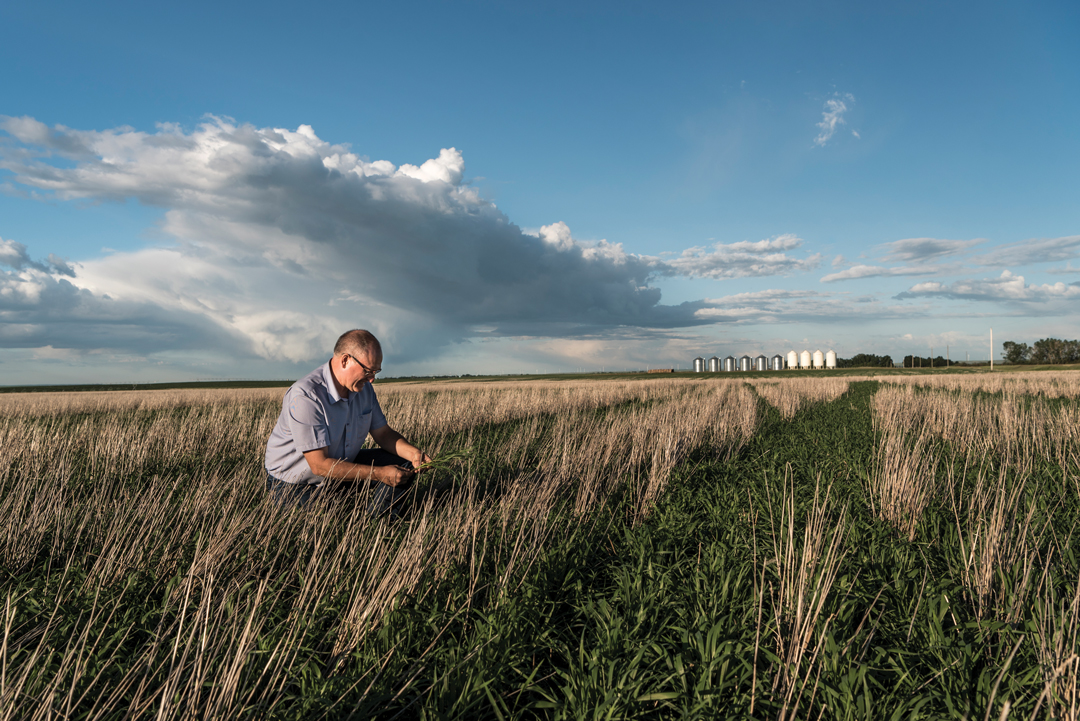AGRICULTURE TAKES ACTION
ALBERTA FARMERS AHEAD ON SUSTAINABILITY
BY TAMARA LEIGH
For farmers, sustainability is the foundation of the future. As Albertans become more interested in where our food comes from and how it is grown, we naturally want to know how farms measure up in the use of sustainable growing practices. It may come as a surprise that in many ways the province’s farmers are leaders in developing and adopting farm practices that not only protect environmental values, but support economic viability and social responsibility.
“Sustainability is one of the most important things in farming, if not the most important. If your farm isn’t sustainable, what are you doing for the next generation?” said Kevin Auch, who farms grains and oilseeds near Carmangay.
Prairie farmers have a long history of innovation and of adopting practices that protect these critical resources, the most significant being no-till systems pioneered in Alberta in the 1980s. Most Alberta farmers use this crop-growing system, which does not turn the soil as was once common practice, leaving it relatively undisturbed.
“Tillage is not good for soils—you lose organic matter and the ability to retain moisture, and increase the loss of topsoil to erosion,” said Auch, an enthusiastic proponent of no-till. “We are sequestering substantially more carbon in the soil by practising no-till than what we are using to produce our crops.”
Adoption of no-till was driven by farmers looking for ways to protect their soil from wind and water erosion. It quickly proved itself by increasing crop yields, reducing labour and improving moisture retention. By the early 1990s, it had become the dominant cropping system across the Prairies and continues to be adopted around the world.
No-till has become one of the cornerstones of conservation agriculture, which combines minimal soil disturbance with the use of mulch soil covers and crop rotation in conjunction with other positive practices, including the use of quality seeds and integrated management of pests, nutrients, weeds and water. The Food and Agriculture Organization of the United Nations calls conservation agriculture the “new paradigm for agriculture in the 21st century.”
The sustainability discussion has an important global component to it. In Canada, only two per cent of the population is actively involved in food production, while globally, farmers account for a third of the population and half of its poor. Farmers and consumers may be aware of this disparity, but few feel like they understand how to address it. That’s where international perspectives on sustainability are particularly important.
In 2016, the United Nations created its Sustainable Development Goals, a set of 17 goals and 169 targets to guide its policy making on development issues through 2030. Second on the list of goals is achieving zero hunger. Target 2.4 of this section sets out the economic, social and environmental parameters of sustainable agriculture.
“For Canadian agriculture, the power of some of these global discussions is in getting some agreement on what we mean when we talk about sustainability,” said Robynne Anderson, president of Emerging Ag Inc. and an international expert on agricultural and food policy. “If we have clear goals, it’s more possible for Canadian agriculture to measure what they are doing, hone in and take action.”
According to Anderson, Canadian agriculture stands to do well on meeting targets under the economic dimension, including land productivity, farm profitability and financial resilience. Similarly, Canada’s worker protections, minimum wage standards and rights to land tenure score high on the social targets. The environmental targets serve as both an opportunity to celebrate some of the progressive practices now in place in agriculture, and a reminder that there is still work to be done. She points to four sets of environmental indicators: soil quality, water use, water quality and biodiversity.
“When we look at how we are doing on our soil quality indicators, we are improving due to innovations like conservation tillage, biotechnology, seed drills and stewardship of our soils. One of the reasons that we do so well on soil erosion is that we dealt with it in the 1930s,” she said. “If we can galvanize on some of the other issues—stewardship of nitrogen, improving irrigation technology to minimize water use, or better use of crop rotations, intercropping or [protection of] riparian zones to increase biodiversity—Canadian farmers are very good at adapting.”
Tracking practices and performance on these indicators helps form a picture of how Canadian farmers measure up. At the national level, the Canadian Roundtable for Sustainable Crops (CRSC) has just completed a two-and-a-half-year project to collect information from government and industry sources to assess strengths and gaps.
“There are a lot of sustainability initiatives being undertaken by the agriculture industry. We wanted a broader picture of agricultural sustainability, particularly on the Prairies,” said Susie Miller, executive director of the CRSC.
The CRSC compiled the data from two studies it commissioned, including a survey of 1,600 farmers. Also incorporating information from government sources, it produced a series of 12 sustainability reports now available online (sustainable
crops.ca/metrics-platform). While the reports are intended for international grain buyers, they’re also of interest to consumers.
Miller is impressed by how quickly farmers are adopting new practices to improve sustainability. “The driving force in a business is always the bottom line, but the bottom line and doing the right thing are mutually exclusive,” she said. “Change starts with a few people and grows from there.”
Organizations at the provincial level are gathering data on sustainable farm practices and making it available to farmers. In March, the Alberta Farm Sustainability Extension Working Group launched farmsustainability.ca, a website designed to help farmers align their practices with the various sustainability schemes and purchasing guidelines that are being developed by major crop buyers such as Unilever and General Mills.
“Our commissions are farmer driven and they recognize the need to respond to the changes on the horizon,” said Alberta Barley market development and policy manager Shannon Sereda, who led the development of the site. “We know that farmers are using sustainable practices, we just haven’t been measuring it.”
The website leads farmers through a series of questions about their farm practices in all three major areas of sustainability, directing them to resources that can help them find opportunities for improvement.
“Farm practices have improved so much over the decades,” Sereda said. “When you talk about climate change mitigation and adaptation, farmers are already addressing it by voluntarily taking up new technology at their own expense. They are entrepreneurs who want to do better, and they do.”







Comments